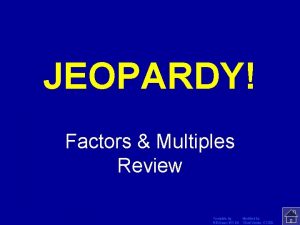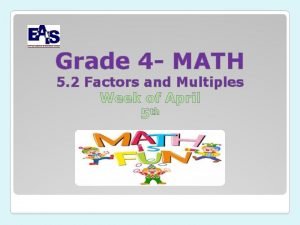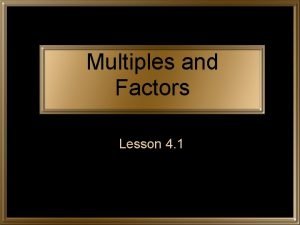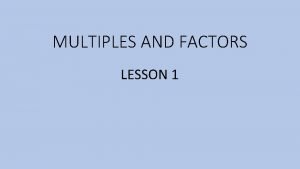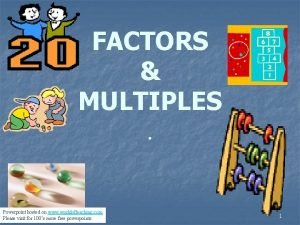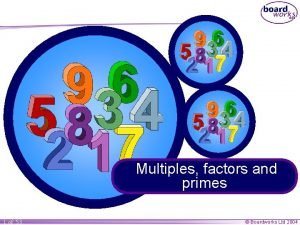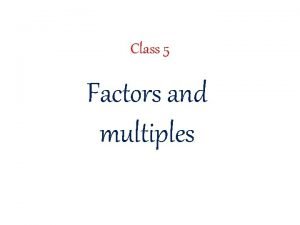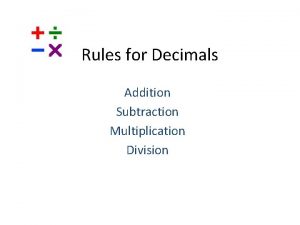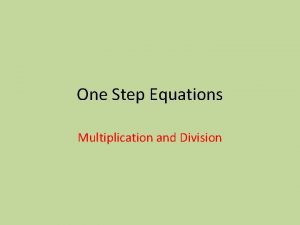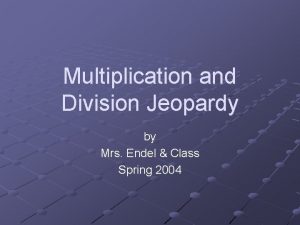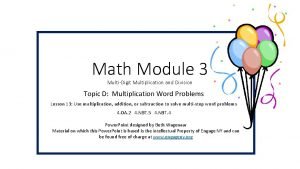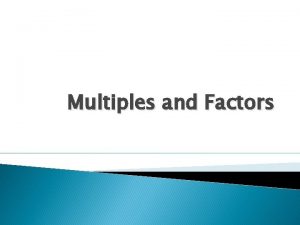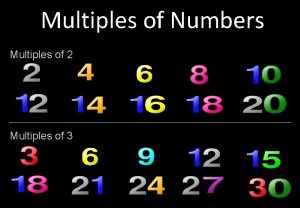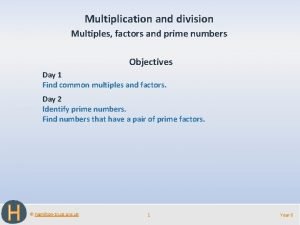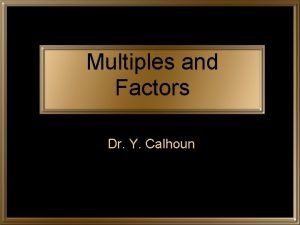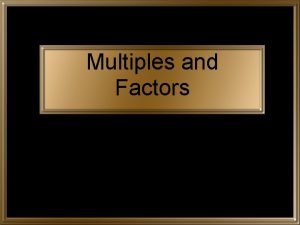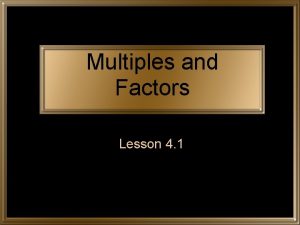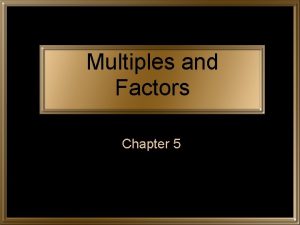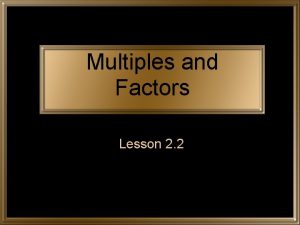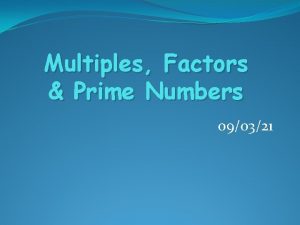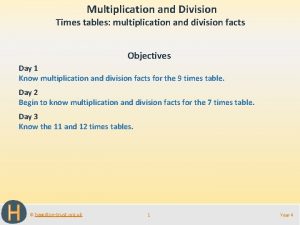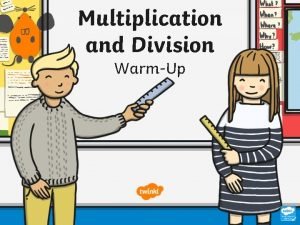Multiplication and Division Factors multiples and mental multiplication


















- Slides: 18

Multiplication and Division Factors, multiples and mental multiplication Objectives Day 1 Revise factors. Use factors to aid mental multiplication. Day 2 Multiply three numbers, recognising where commutativity can simplify a calculation, e. g. 2 × 6 × 5 = 6 × 10. © hamilton-trust. org. uk 1 Year 4

Multiplication and Division Factors, multiples and mental multiplication Starters Day 1 7 times table (pre-requisite skills) Day 2 11 times table (pre-requisite skills) © hamilton-trust. org. uk 2 Year 4

Multiplication and Division Factors, multiples and mental multiplication Starter 7 times table © hamilton-trust. org. uk 3 Year 4

Multiplication and Division Factors, multiples and mental multiplication Starter 11 times table © hamilton-trust. org. uk 4 Year 4

Multiplication and Division Factors, multiples and mental multiplication Objectives Day 1 Revise factors. Use factors to aid mental multiplication. © hamilton-trust. org. uk 5 Year 4

Day 1: Revise factors; Use factors to aid mental multiplication. 20 x 36 List ALL the pairs of factors of 20, i. e. the pairs of numbers that multiply together to make 20. How could we work out the answer? We can multiply 36 by 2, then by 10 (or vice versa). Do this to work out the answer – you are using the factors of 20! How else could we multiply by 20? Which way did you find quicker or made more sense? Multiply 36 by 4 (doubling twice) and then by 5. Do you get the same answer? © hamilton-trust. org. uk 6 Year 4

Day 1: Revise factors; Use factors to aid mental multiplication. 14 × 52 List ALL the pairs of factors of 14, i. e. the pairs of numbers that multiply together to make 14. Use a pair of factors of 14 to work out the answer (7 x 52 then…). Now use partitioning, i. e. (10 × 52) + (4 × 52). Do you get the same answer? Which way did you find quicker or made more sense? © hamilton-trust. org. uk 7 Year 4

Day 1: Revise factors; Use factors to aid mental multiplication. 24 × 25 List ALL the pairs of factors of 24, i. e. the pairs of numbers that multiply together to make 24. I’m going to choose a pair of children to help us work out the answer. Would you have worked out the answer in the same way? © hamilton-trust. org. uk 8 Year 4

Investigation: Adult Sheet © hamilton-trust. org. uk 9 Year 3/4

Investigation: Child Sheet © hamilton-trust. org. uk 10 Year 3/4

Challenge © hamilton-trust. org. uk 11 Year 4

Multiplication and Division Factors, multiples and mental multiplication Objectives Day 2 Multiply three numbers, recognising where commutativity can simplify a calculation, e. g. 2 × 6 × 5 = 6 × 10. © hamilton-trust. org. uk 12 Year 4

Day 2: Multiply three numbers, recognising where commutativity can simplify a calculation, e. g. 2 × 6 × 5 = 6 × 10. 2+7+8 How would you work this out? We can add in any order, so we could add 2 and 8 to make 10, then add the 7 on! Multiplication can be done in any order, just like addition, to arrive at the same answer. Work out 1 × 2 × 3 and 3 × 1 × 2. We call this property ‘commutativity’. © hamilton-trust. org. uk 13 Year 4

Day 2: Multiply three numbers, recognising where commutativity can simplify a calculation, e. g. 2 × 6 × 5 = 6 × 10. 4× 7× 5 How could we change the order of this multiplication to help simplify the calculation? e. g. 4 × 5 × 7, i. e. working out 20 × 7. 7× 2× 8 7 × 8 × 2 is probably a simpler order to work with because the second step involves finding 56 × 2, rather than 14 × 8. How could we change the order of this multiplication to help simplify the calculation? © hamilton-trust. org. uk 14 Year 4

Challenge © hamilton-trust. org. uk 15 Year 4

Multiplication and Division Factors, multiples and mental multiplication Well Done! You’ve completed this unit. Objectives Day 1 Revise factors. Use factors to aid mental multiplication. Day 2 Multiply three numbers, recognising where commutativity can simplify a calculation, e. g. 2 × 6 × 5 = 6 × 10. © hamilton-trust. org. uk 16 Year 4

Problem solving and reasoning questions Find three different multiplication facts that you can multiply by 10 to give an answer of 400. Use doubling to help you help solve: 23 x 4 18 x 8 141 x 4 How could you use the factors of 12 to help multiply a number by 12? Try this to find: 16 x 12 23 x 12 34 x 12 Use and explain a mental method to find: 8 x 13 7 x 16 12 x 13 © hamilton-trust. org. uk 17 Year 4

Problem solving and reasoning: Answers Find three different multiplication facts that you can multiply by 10 to give an answer of 400. Any of 1 × 40, 2 × 20, 4 × 10, 5 × 8. i. e. the factor pairs of 40. Use doubling to help you help solve: 23 x 4 18 x 8 141 x 4 23 × 2 = 46; 46 × 2 = 92 18 × 2 = 36; 36 × 2 = 72; 72 × 2 = 144 (Or 9 × 8 = 72; 2 × 72 = 144) 141 × 2 = 282; 282 × 2 =564 Errors may occur when children are working mentally but do not jot down the part completed solutions; some errors also possible when doubling if double the 1 s digit is greater than 10, e. g. 46 × 2 = 82 or 812. How could you use the factors of 12 to help multiply a number by 12? Multiply by 3, then by 2 again – this could be in any order Try this to find: 16 x 12 = 192 23 x 12 = 276 34 x 12 = 408 Use and explain a mental method to find: 8 x 13 7 x 16 12 x 13 8 x 13 = 104, e. g. double 13 three times. 7 x 16 = 112, e. g. 7 x 8 = 56, then double 56. 12 x 13 = 156, e. g. 3 x 13 = 39, then double twice. Other methods are possible. The important thing is a) getting the right answer and b) children being able to explain their strategy. © hamilton-trust. org. uk 18 Year 4
 Gcf of 48 56 and 72
Gcf of 48 56 and 72 Factors grade 4
Factors grade 4 2 x 8 =
2 x 8 = Lesson 1 factors and multiples
Lesson 1 factors and multiples Factors and multiples powerpoint
Factors and multiples powerpoint Factors multiples and primes worksheet gcse
Factors multiples and primes worksheet gcse Factors and multiples in real life
Factors and multiples in real life Factors of 53
Factors of 53 Prime factors of 72
Prime factors of 72 Lowest common factor
Lowest common factor Factors and multiples class 5
Factors and multiples class 5 Highest common factors and lowest common multiples
Highest common factors and lowest common multiples Greatest common factor and least common factor
Greatest common factor and least common factor Chapter 20 mental health and mental illness
Chapter 20 mental health and mental illness Rules of subtracting decimals
Rules of subtracting decimals One step equation multiplication
One step equation multiplication Multiplication and division properties
Multiplication and division properties Math jeopardy multiplication and division
Math jeopardy multiplication and division 13773x
13773x
